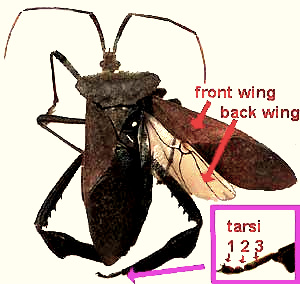For help in understanding how the following key works, check out our Identification Keys page.

For help in understanding how the following key works, check out our Identification Keys page.

| 1 Wings absent or, as with beetles, hind wings hidden beneath thick, sometimes hard, sometimes leathery, front wings, or wing coverings (Careful: If there's a crack down the back, probably that's where the thick front wings meet, with regular flying wings folded below, as in the above image...) | Go to... 7 |
| 1 Wings clearly visible when the insect is at rest, not hard like thin plastic | 2 |
|
|
|
|
2 Not butterflies & moths; mouthparts not coiled tubes; wings not covered with tiny colored scales |
3 |
| 3 Two pairs of wings | 4 |
|
4 Front wings longer and with considerably larger surface area than hind wings |
5 |
|
4 Front wings with about the same area as hind wings |
6 |
wasps & bees |
|
cicadas, aphids |
|
|
|
|
|
|
termites |
| 7 Wings entirely absent | 8 |
| 7 With wings, though they may be hidden beneath a hard or leathery wing covering; look for straight crack down back, where thick wings meet | 12 |
|
|
(worker ants, etc.) |
|
8 Bodies thicker |
9 |
cicadas, aphids |
|
| 9 Bodies more slender | 10 |
|
|
termites |
|
10 Most of body not whitish, usually hard-bodied |
11 |
 11 Antennae with 4 or 5 segments, mouth parts sucking 11 Antennae with 4 or 5 segments, mouth parts sucking |
true bugs |
 11 Antennae with many segments, mouth parts chewing 11 Antennae with many segments, mouth parts chewing |
grasshoppers, crickets |
|
|
|
|
12 Rear end without tweezers-like appendages |
13 |
| 13 Mouth parts sucking, usually straw-like | 14 |
| 13 Mouth parts for chewing | 15 |
|
|
true bugs |
|
|
cicadas, aphids |
grasshoppers, crickets |
|
OK, the test insect is a Hemiptera, a "true bug." It's a Leaf-footed Bug of the family Coreidae, but I'm unsure what its genus and species are.
You might like to look at the Earthlife.net's more extensive key to the orders.